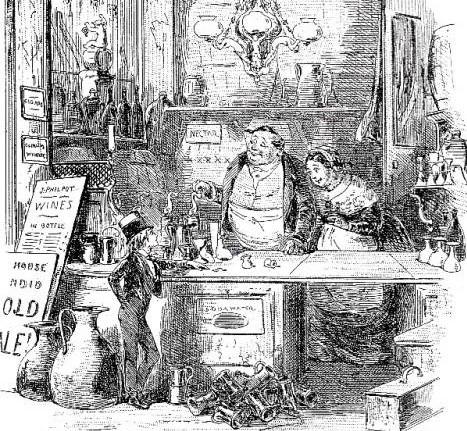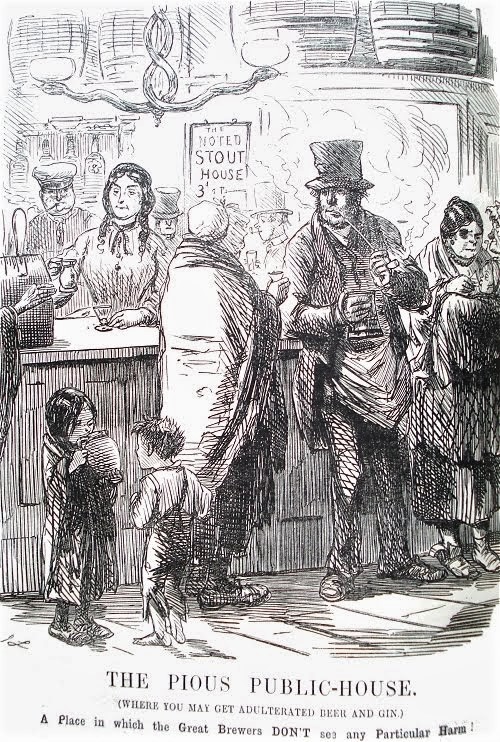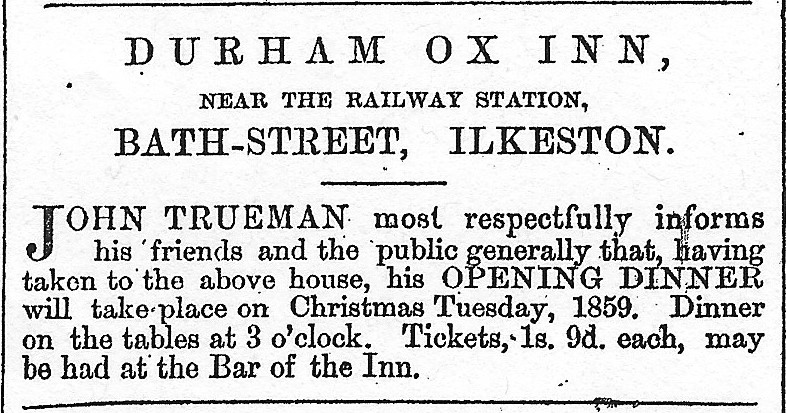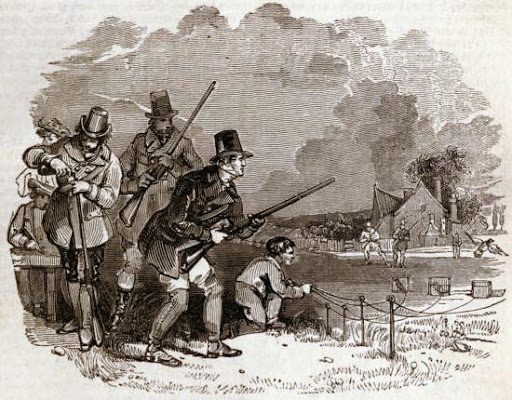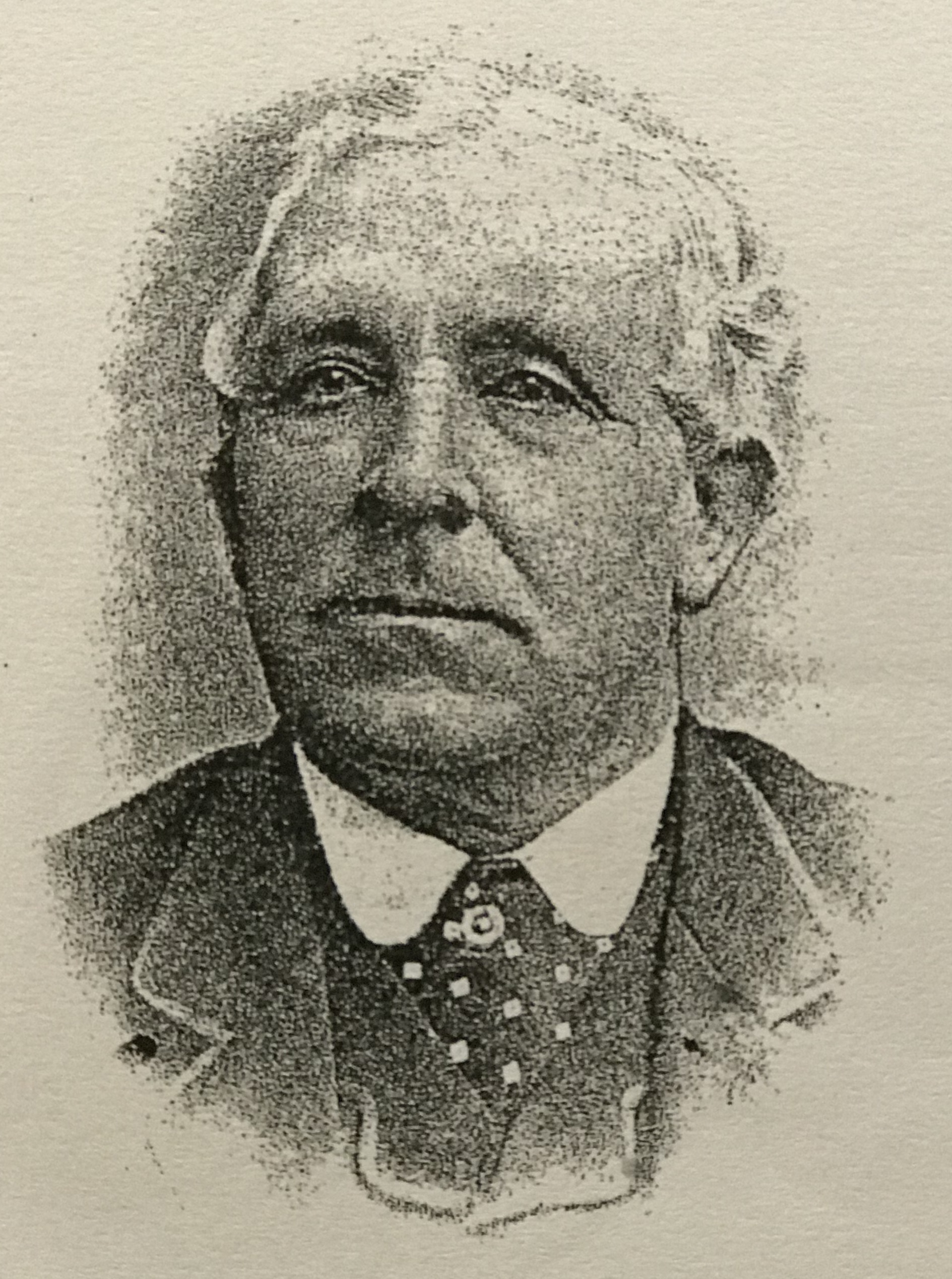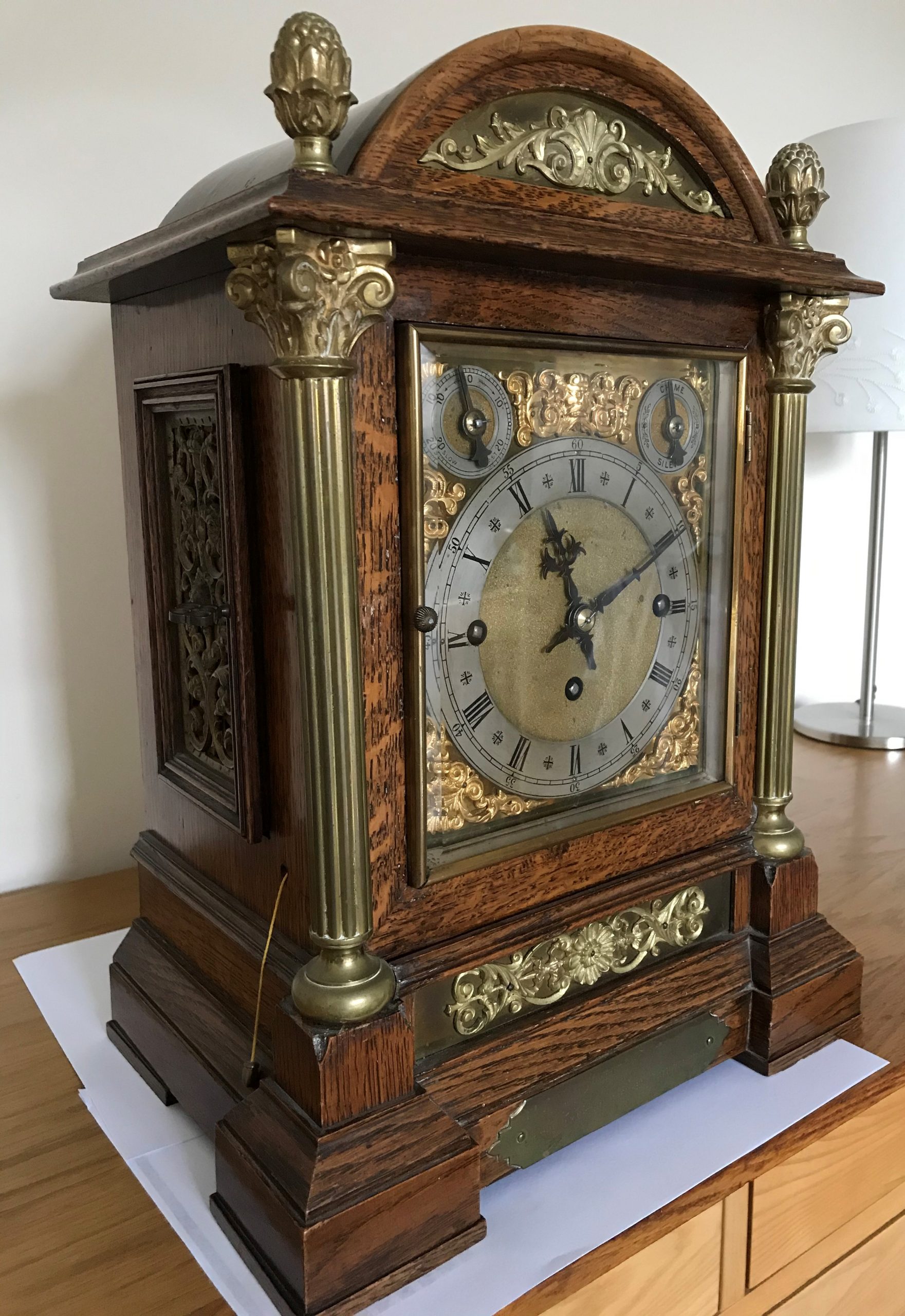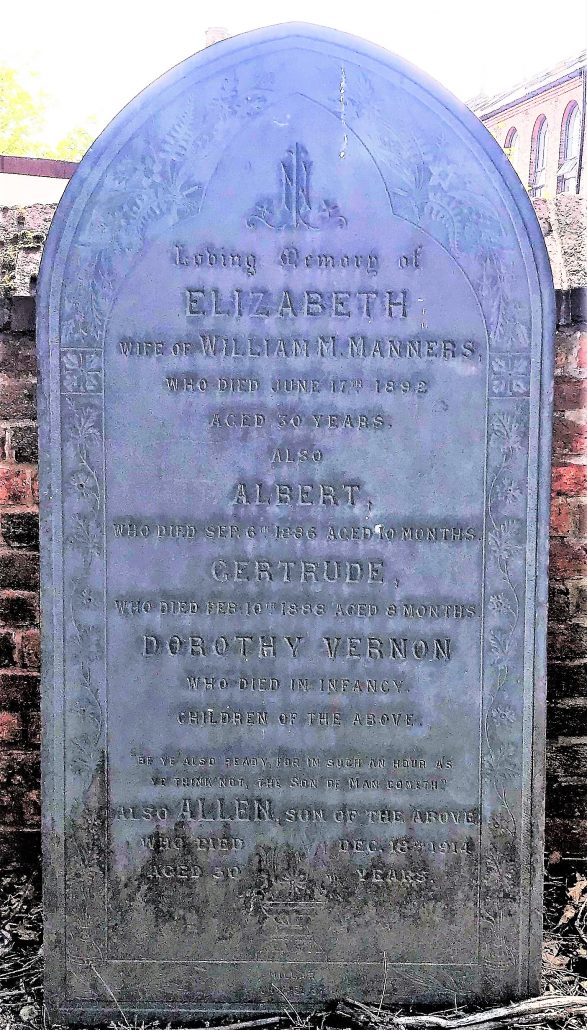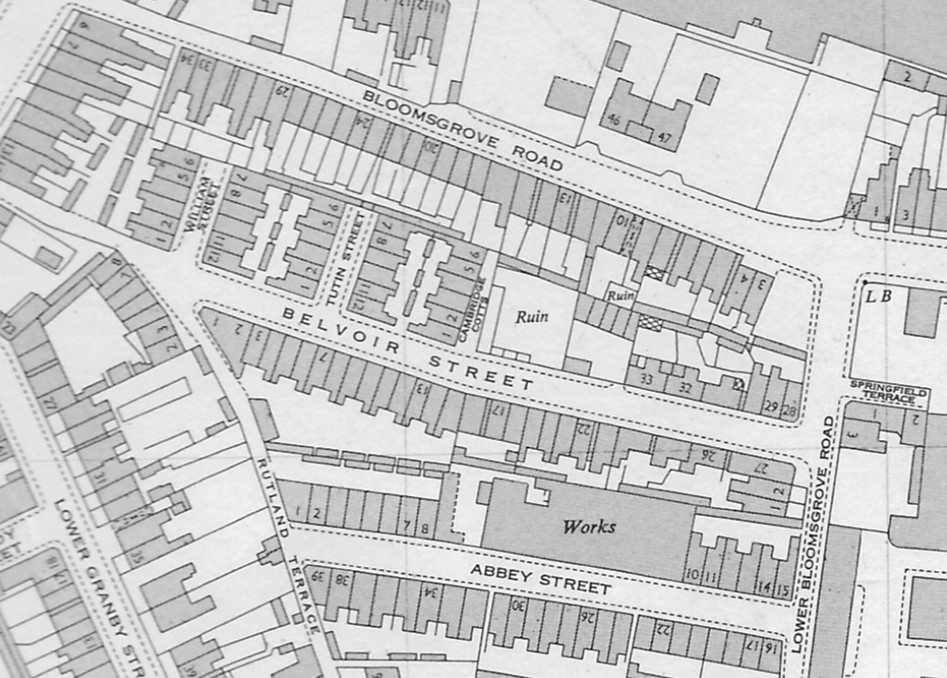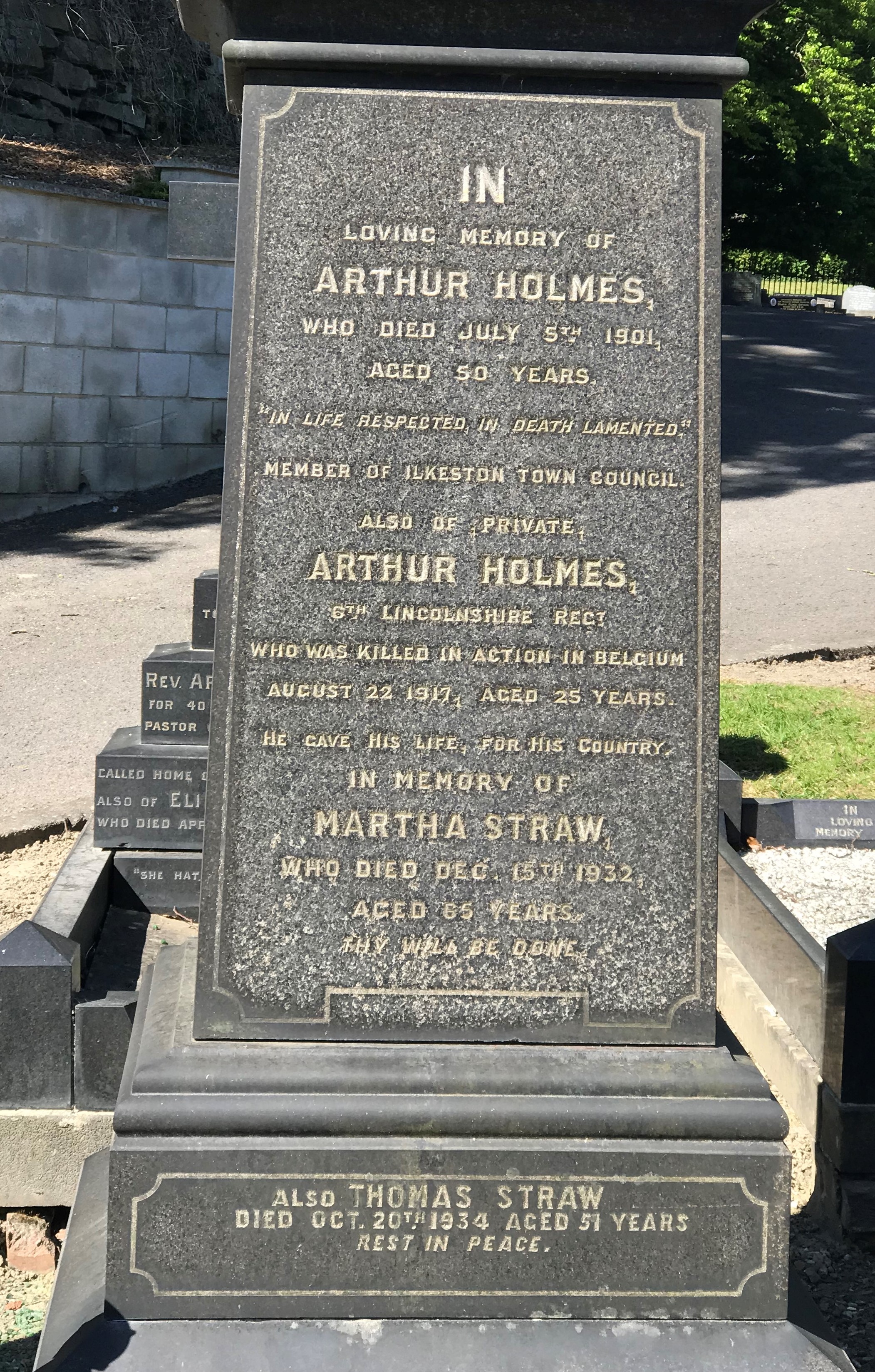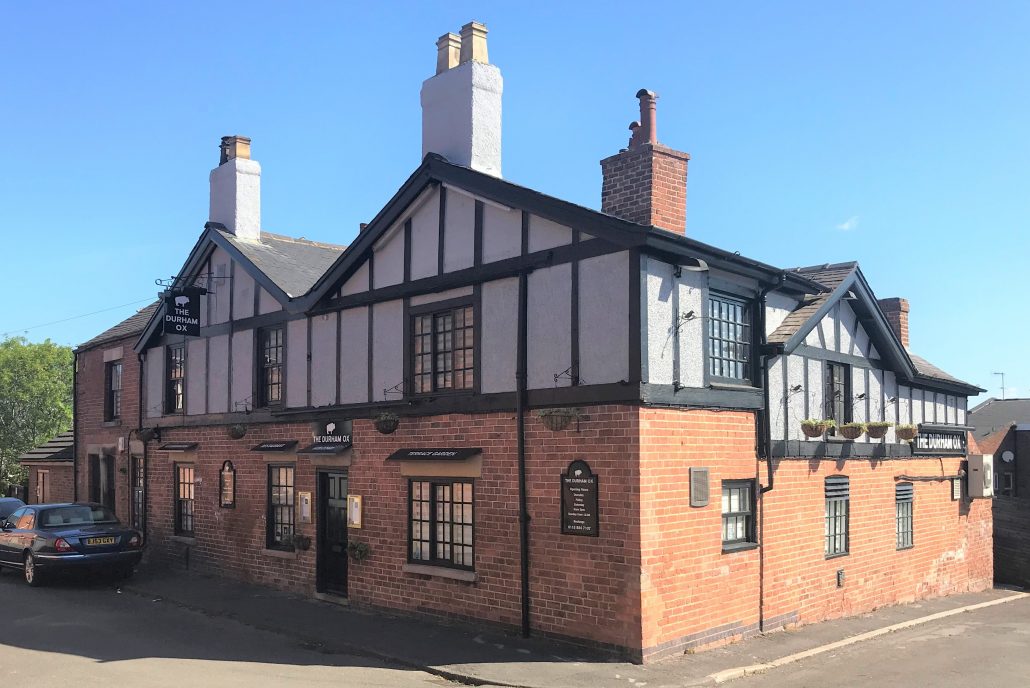The first of many !!!
We have really only just started our walk around the town and already we are saying goodbye to William Riley, the unfortunate butcher. Our guide, Adeline, leads us to “the Durham Ox which was next”. It is the first of many drinking establishments we shall meet (and enter !!) in the course of our journey around the town. So we will pause here to briefly consider the background to the variety of pubs, beerhouses, etc in Victorian Ilkeston.
———————————————————————————-
A few terms of clarification for non-drinkers — and drinkers —
Since the 15th Century an Inn suppied food and drink, accomodation for travellers, and stables for horses; a tavern offered just food and drink, while an alehouse brewed and sold beer and ale, but had no license to sell spirits.
A victualler provides food and provisions for customers while a licensed victualler has a licence to provide alchoholic beverages also.
The Alehouse Act (1828) gave local magistrates complete control over the granting of licences to sell ale etc. The grant was made at the Brewster Sessions, a general annual licensing meeting, and a licence was granted if the licensee promised not to adulterate his liquors, used legal measures, didn’t permit drunkenness, gambling or disorderly conduct on his premises, and made sure he was closed during Divine Service on Sundays, Christmas Day and Good Friday.
Under the Beerhouse Act (1830) there was now no need to apply to the local magistrates for a licence to sell certain types of liquor, mainly beer. Any householder assessed to the poor rate could purchase an excise licence from the local excise officer for a modest price — initially two guineas (£2 2s) per year — and then commence to brew and sell beer, ale and cider from his own premises, either on or off. Hence we see the appearance of the beer house. In the first three months of the Act being passed 24,342 licences were issued; these new ‘houses’ were named as “Tom and Jerry shops” after two dissolute and rakish fops of that era.
Tom and Jerry in London in the 1820s
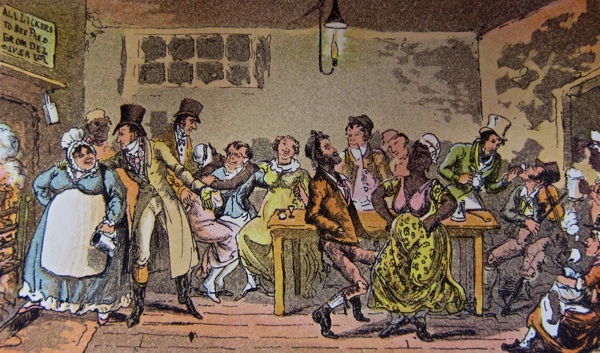
The Act also extended opening hours to 18 hours per day, usually from 4am to 10pm. However the Beer retailer found it hard to compete with publicans who were allowed to sell spirits too; so they often adulterated their beer in order to sell at lower prices, and permitted all sorts of conduct on their premises to attract custom.
In 1834 the Act was slightly modified — a distinction was made between ‘on’ and ‘off’ sales, and anyone who wanted to get a licence to sell beer on the premises had to produce a certificate of good behaviour signed by six rate-paying members of the parish.
By 1840 there was a concern that too many beerhouses were being set up, and so to slow down the growth another modification was made. A new licence for both on or off sales would only be granted if the premises had a specified annual value and the licence-holder had to live in the house.
And this situation lasted until 1869 when we get another new Licensing Act. Once more Justices were granted the sole right to issue licences, and an alehouse keeper had to have a Justices Licence before he could obtain an Excise Licence to sell his beer. This applied to both on and off sales.
Now is that clear ?!
Public Houses at the dawn of the Victorian Age
Here is a list of Ilkeston’s public houses as the town entered the Victorian Age, with the name of the landlord/s and location.
Ancient Druids … At Cotmanhay, it was occupied by Robert Booth
Boatswain … At Bottom Road/the Pottery; this appears on the 1798 map, owned by Thomas Potter who was still the owner in 1817 though the tenant was William Rhodes. By 1818 William Burgin Richardson had taken over as landlord and then he was followed by his son James (at the death in 1830 of his father William, who was the brother-in-law of Mark Attenborough). For a short time he was helped by his mother Elizabeth (nee Attenborough) until she left for West Hallam, to live with daughter Marina.
Bull’s Head … At Little Hallam; the pub premises appear on the 1798 Enclosure Map (though perhaps not under the Bull’s Head name) owned by Isaac Atkins and his wife, who had just moved from the Anchor Inn in Lower Market Place. About 1805 Isaac sold the property to William Bower, with the latter’s son Thomas as landlord. Thomas occupied this until the late 1830’s when he went off to farm at Stanley. On the 1841 Census James Syson is landlord
Harrow … In Lower Market Place; it appears on the 1798 Map, owned by Gilbert Walker and by 1817 was owned by William Blunstone, with William Severn as landlord. The landlord died in 1818 and for a few years it was in the hands of his widow Phoebe Severn (nee Leggitt) until she remarried in 1822, to Thomas Bennett who then became landlord.
Horse and Jockey … at Gallows Inn; it appears on the 1798 Enclosure Map, owned by Thomas Hunt who died in 1812. In that year it was purchased by John Lowe who was landlord until the mid-1830s when suceeded by Edward Severn though it was still owned by John Lowe. The latter died, unmarried, in 1837 and the inn passed to his brother Christopher Lowe but with the same landlord
King’s Head … In the Market Place; there is no evidence of it on the 1798 or 1817 Surveys. However in the late 1820s it had landlords William Jackson (up to about 1830) then John Bates (up to about 1839) and then William Woodruffe
Peacock … At Cotmanhay; Mary Knighton (nee Jackson), widow of Joseph, was landlady until her death in 1833 when Ralph Buckland, her nephew, took over
Queen’s Head … In Bath Street; Benjamin Wade was landlord until the late 1830s, followed by his son-in-law William Moreland, (second husband of Sarah Wade)
Rose and Crown … At Cotmanhay; from 1821 it was occupied by Thomas Noon, and then in the 1830s by Joseph Aldred (whose wife Amy Knighton was the sister of Thomas Noon’s wife Ruth)
Rutland Arms … In Bath Street; from 1818 (at least) it was occupied by the Hives family, first by John, and then by son Thomas (probably after John’s death in 1834)
Sir John Warren … In the Market Place; on the 1798 Survey the property is owned by Isaac Attenborough, though described only as two houses and a garden, not a public house. Some time between then and 1818 it was converted, so that Isaac was the first landlord. In 1819 his son Mark took over the Inn.
Three Horse Shoes … In Moors Bridge Lane (later called Derby Road); from 1825 William Rowliston was landlord.
White Lion … In Nottingham Road; it is included in the 1798 Map and Survey as a public house owned by Henry Skevington; James Wilson was landlord at least since 1817.
Among other sources, I have used Gauntley’s Enclosure map and survey of 1798, his later Survey of 1817, the Register of Victuallers licensed in Ilkeston 1818-1827, several Trade Directories, and the 1841 Census to compile the list above. Those named in bold black appear in the Register of Victuallers; those in bold red do not appear in the Register — so I am assuming that they did not exist as licensed premises until after 1827.
There was also the Wine Vaults in East Street, although this was classed as a ‘Wine Merchant’.
On the 1798 Enclosure Map the old Anchor Inn is also shown; this was on the east side of the Lower Market Place and was owned by Thomas Bradley junior, though in 1799 he sold it to John Shaw of Trowell. In 1825 the premises (no longer an Inn) were acquired by Matthew Hobson.
You may think the above list is incomplete as it doesn’t contain names you are familiar with. However, remember that the list doesn’t include beerhouse/alehouses, a different ‘species’ of drinking establishment.
A public house about 1850 (Philip V Allingham)
In the year of Adeline Columbine’s birth — 1854 — the Nottinghamshire Guardian included a short paragraph from the ‘Builder’ periodical under the heading of ‘Public Houses’.
“As the term denotes, these establishments are open for public accommodation, and the law makes it imperative on the owners holding licence, to give hospitality; besides that, it imposes on them other duties not of an agreeable nature, such as billeting soldiers, receiving the bodies of suicides, &c; they are restrained from receiving customers during divine service, but are forced to admit them at other times; they are heavily amerced for suffering brawls or bad characters to congregate; and (will it be credited !) they are subject also to serious penalties for adulterating liquor !”
A cartoon from Punch
“What an arduous office the publican has to perform.
“And still, notwithstanding all this, we find these houses increasing every year, until at length in England and Wales they number 61,040 as having spirit licence; and including those licenced for the sale of beer only, they amount to 101,953; being in excess of any other trade, and averaging against the whole population in the ratio of one public-house for every 120 souls! 102,000 public-houses for 12 millions of people! How many churches are there? The latter are built at an enormous national cost, and yet do not accommodate one-half of the population — the former are supported by voluntary contributions, and suffice for all at once.
“The fact is startling, and ought to excite the earnest attention of Government. Whether that attention is bestowed on the subject which its importance demands, is the question. Are these places of rendezvous , of universal and habitual intercourse, at all regarded, except as sources of revenue? Is the quality of the beverage vended ever checked or tested? Or are the proper guarantees for good management duly secured?
“These are points which concern the great moralists of Exeter-hall,* and until they direct their efforts towards the reformation of white slaves (slaves of bad habitudes, of abject condition, and of neglect), at home, chancellors of the exchequer and finance committees, finding them promotive of revenues, in the principal branches of beer, spirits, and tobacco (producing each its five millions a year, will not interfere with them”.
*Exeter Hall in the Strand, London served as a meeting place for the Anti-Slavery Society and other organisations in the 185os. It was also a concert hall.
Ten years after this description, Victuallers’ licenses were being renewed at Smalley Petty Sessions (August 22nd 1864), when it was revealed that Codnor and Loscoe had 9 such licenses, Codnor Park had 1, Dale Abbey 2, Denby 3, Heanor 12, Horsley 2, Horsley Woodhouse 3, Kirk Hallam 0, Mapperley 1, Morley 1, Pentrich 3, Ripley 12, Sandiacre 3, Shipley 1, Smalley 3, Stanley 1, Stanton-by-Dale 2, West Hallam 3 ….. and Ilkeston 25 !!!
Depending upon one’s point of view, Ilkeston was either very fortunate or extremely disadvantaged by its wide choice of drinking premises. And the situation ten years after this wasn’t much changed, as our visit to the Brunswick Hotel, just up the road, will show.
———————————————————————————-
As we walk up Bath Street we can glimpse eastwards. “Beasts and sheep might be seen grazing leisurely. Looking across this pasture, a glimpse of the Durham Ox Inn (kept by Mr. John Trueman, a noted crack shot) could be obtained”. (Sheddie Kyme).
The scene was hardly ‘leisurely’ in the winter of 1859-1860 which seems to have been a rather bad one for storms.
Just before New Year, Friday afternoon, the skies went black, preceding thunder, lightning, torrential rain and an accompanying whirlwind. The latter swept from the bottom of Bath Street and into Twells’ fields, attacking the haystacks there and showering straw and hay over the surrounding houses. One such house also lost its pantry and outhouse, and as a consequence Twells’ Close found itself with several alien doors and wooden boards.
Numerous other houses lost slates while in Brussels Terrace a resident was covered in glass as his window blew inwards.
A little further east in Pigsty Park recently built houses lost their gable ends and several trees were snapped off at the ground.
John Trueman (1831-1909)
Born on Ilkeston Common on August 8th, 1831, John Trueman was the youngest child of coalminer James and Sarah (nee Bostock) and started work in a local colliery before the age of nine. He moved on to Stanton Ironworks where he worked for over 20 years.
In October 1854 he married Ann Cope, who was born at St Johns (or Saint John) in New Brunswick, Canada while her father Samuel was serving there with the Royal Artillery.
In August 1859 John opened the Durham Ox in Belvoir Terrace — later known as Durham Street.
Originally built as a private residence and later used as a police office, it was converted by John into a beerhouse which opened at Christmas time in 1859 and where John was landlord for nearly 22 years.
Ilkeston Pioneer Dec 15th 1859
John the Sportsman
During his life landlord John Trueman was particularly fond of shooting contests and won several prizes against large numbers of competitors at Nottingham, Sheffield and other places.
In September, 1860 John was engaged in a pigeon shooting match with Thomas Marson, landlord of the Jolly Boatman Inn on Awsworth Road, on away territory, ‘at five birds for a supper’.
‘Crack shot’ John bagged two out of five of his targets and this was two better than Thomas (or ‘worse’ for the pigeons).
A return match was called for a fortnight’s time at the Durham Ox where ‘plenty of pigeons will be provided for a sweepstake’.
The Pioneer was happy to report this but was far less happy about the pigeons in Chapel Street at the same time (see Into Chapel Street).
At the age of 50 John bagged another first prize when he travelled to Oughtibridge near Sheffield to compete in the Old Man’s Leger, an All-England pigeon-shooting contest for competitors aged 50 plus.
In June 1861 the Durham Ox was up for sale (IL) but thereafter still showed John as landlord.
Pigeons were not the only birds in danger from John and his shooting buddies.
For example, in February 1876, the landlord organised a Sparrow shooting contest at his Inn. First prize, a double barrel shotgun.
There were 13 competitors – and guess who won?
John bagged six out of seven while son James shared second and third prizes (£1 5s) with two others, each missing two targets.
Following the contest and over a splendid spread at the Durham Ox, two further pigeon shooting matches were arranged for early March, to bring the shooting season to a close.
The shooting of pigeons was a popular winter ‘sport’ but was not universally welcome at this time as an article in the Lancet of Spring 1877 reported. It complained that the caged birds were often so exhausted that when their trap was opened they were too tired – or too tame – to fly away, and the shooting of them was more a brutal slaughter than a sporting contest.
In 1878 John was connecting the drain at the Durham Ox with the sewer in Northgate when he found several of the pipes in the street were broken. He set about replacing them and asked the Local Board to meet the cost.
Its surveyor, George Haslam, reported that John had done a good job and so the Board agreed to pay the bill for the pipe work which had been supplied by Richard Evans.
———————————————————————————-
John the Victualler and Brewer
About 1880 John had commenced business as a brewer and with James O’Hara eventually established the Trueman and O’Hara brewery in Durham Street.
In July 1881 the Inn’s licence was transferred to Samuel Straw.
In April 1883, John — still busy brewing though — wrote to Holmes’ Brewing Trade Gazette to tell that publication that he had tried their patent finings and hop substitute, and had found them wholesome and good, and of great benefit to him, as a small brewer.
Though John continued with his brewery business he now left the Durham Ox and moved on to the Horse and Groom at Gallows Inn, (where his manager was son-in-law Owen Bostock — son of William and Sarah (nee Henshaw) — and who had married Sarah Trueman in 1874), and to the Queen’s Head in Bath Street.
On a Wednesday in January 1886 Owen Bostock’s eight-year old son John attended Trowell School in the morning as usual and on the way home went onto the frozen Nottingham canal to slide. What he didn’t know however was that on the previous day an ice boat had been along the waterway so that the newly formed ice was now very thin.
It collapsed as John went onto it and he fell beneath the water. His lifeless body was recovered by drags about an hour later.
In the Spring of 1885 the Licensed Victuallers’ Association of Ilkeston was formed and John Trueman was its first President. After one week, total membership had grown to 50. By November 1894 that number had grown to 64 and John remained President. However the Association now felt under threat on several sides. There was an ‘attack’ from a relative insignificant (and as it proved, short-lived) source — that of the Theatre Royal in Rutland Street which had just obtained a renewal of its drink licence and thereby was extra competition for members in that neighbourhood. Of much more importance however was the strength and financial resources of the Temperance Movement which was willing to spend several thousands of pounds in its fight against the liquor trade. They also had to contend with increased taxes, the burden of billeting soldiers and the growth of spurious ‘clubs’ which stayed open after public-houses were forced to close and where men could drink all night if they wished.
Members of the Association were under the impression that in the late 1880s and into 1890/91 the Magistrates (made up of many teetotallers) had conducted their own war against the trade, supported by the Town Council and egged on by the Temperance movement … an impression which had some justification. Yet despite all of these obstacles and hearing a series of rousing speeches, the members left the Annual Meeting in November of that year with a sense of optimism.
Ten years after its formation and John was still the president of the Association … and spirits were high !!! (every pun intended !!) The recent General Election had returned very pleasing results for the victualling trade, both nationally and locally. And the same appled to the more recent municiapl elections. It was clear that they had the confidence and support of the public — at least that was the view expressed at the annual meeting in November 1895. They were more than a match for the Temperance ‘faddists’.
At the end of that year John was feeling very poorly and had decided that now was the time to resign his presidency of the Association. The post was then filled by Charles Hiram Gregory.
There was also an Ilkeston Off-Licence Association, formed in 1889, though its members still had to trek over four miles, to Heanor, to have licensing matters dealth with !! The members were not happy with that. By 1895 all but two off-licence holders had joined the Association, whose President was then Samuel Wood. On August 31st, 1896 an application was made at Heanor Brewster Sessions to have licensing issues at Ilkeston and villages to the south dealt with at Ilkeston in future. The application was approved in the following month.
When the Association held its annual dinner at the Rutland Hotel in October 1898 it proclaimed that not a single member had been prosecuted during its nine-year history. It now had about 40 or 50 members out of a total of about 60 off-licence holders in the Ilkeston Division.
———————————————————————————-
John in retirement
John Trueman retired from business on March 2nd 1896 through failing eyesight.
This rosewood clock with gold adornments was presented to John Trueman by the Ilkeston Licensed Victuallers Association, November 4th 1897, on his retirement. It is now in the possession of Graham Shead who has kindly sent the images. Graham believes that it has come to him via his Bostock connections. At the same time John’s wife Ann was presented with an inscribed silver teapot. Both presentations were made by the then president of the association, Charles Hiram Gregory at the Horse and Groom Inn (landlord Tom Mycroft)
In the prime of his life John was a man ‘of fine physique’, almost six feet tall and weighing 15 stones. However in the last years of his life he went blind, ‘due to shock’.
In the late 1890s John had built properties in Stanley Street — two freehold premises (numbers 1 and 2) and two freehold villas adjoining them (numbers 3 and 4), collectively known as Trueman Villas, He and Ann lived at number 1 while the Rev. John Thomas Bell, Curate at St. John the Evangelist in Nottingham Road, lived at number 2. Each of these houses had a dining room, drawing room, kitchen, scullery, pantry, four bedrooms, bathroom and w.c., as well as an enclosed yard and outhouses.
In October 1904 John and Ann celebrated their Golden Wedding and both died at Number 1 Stanley Street in 1909 and 1916 respectively.
John succumbed to bronchitis following a chill. The local press was fulsome in its praise for John …. ‘one of Ilkeston’s best known sportsmen…. exceedingly well known all over the Midlands … a clever shot , having gained many honours in shooting competitions at Nottingham, Sheffield and other places.’ (Belper News) There was a burial ceremony at the Congregational Chapel in Wharncliffe Road, attended by a large congregation before John’s body was interred in Park Cemetery.
———————————————————————————-
The children of John and Ann Trueman
Harriet Trueman was born on November 13th 1854, less than three weeks after her parent’s wedding. She married collier Herbert Bostock on August 27th, 1877 and continued to live in Ilkeston, at Belvoir Terrace and then in Bath Street, where the Bostocks kept a Refreshment House at number 17.
Harriet died at 10 Jackson Avenue on February 17th 1940, then a widow.
Sarah Trueman, born on December 31st, 1855, married Herbert Bostock’s younger brother Owen on July 14th 1874.
James Trueman, born February 20th, 1858 … and then ?
Mary Ann Trueman, born on September 28th 1860, married Hull-born bricklayer Edward Longfield Clayton in 1879. She died in 1896 and three years later, on October 29th, 1899, her widower married Ellen Handley (nee Tyler), daughter of Nottingham cigar manufacturer William Tyler.
Elizabeth Trueman was born in Belvoir Terrace on April 17th, 1862. On May 18th 1880 she married William Manners Manners, a bricklayer of West Hallam, living then in Granby Street and afterwards at Cotmanhay Road.
I am not sure that the decade following the marriage was one of happiness and contentment for the couple, but it did lead to seven children, the last one being born in 1890 (Dorothy Vernon Manners). It also led to the couple appearing at Ilkeston Petty Sessions, on May 14th 1891, practically on their wedding anniversary, though I doubt that was foremost on the mind of Elizabeth. She appeared at the court to relate a tale of serious marital cruelty. Her evidence was of a husband — a Town Councillor to boot !! — who drank far too much, left her and the children without food to eat, except bread and dripping, in anger struck her across the head with his walking stick, locked her out of the house, and threatened to kill her. She had been regularly brutalised and on several occasions had sought refuse at the home of her neighbour, James Stanley Tate, the Curate of Holy Trinity Church.
Her husband, however, had a different story to tell — of a slovenly and dirty wife, who neglected her children and her household chores, who drank often, and who was handsomely provided for. He had struck her but only by accident, as he was twirling his stick.
Several witnesses were called who generally supported the picture of William as a miserable, misanthropic individual — he had recently kept the Commercial Inn on Awsworth Road and was often in arguments and physical conflict with his customers there.
The magistrates (one of whom was the Mayor) were satisfied that William should be fined for the assault, and that a judicial separation was justified; the husband would pay 12/6d per week for his wife and children (four of whom were still living).
However, William would not let the matter lie there. He was soon accused of accosting his wife in the street, of using foul language against her, and of threatening to blow her head off (once more !!). In turn, when he appeared at Ilkeston Petty Sessions once more, William was all sweetness and light — he had not threatened his wife but had spoken reasonably and calmly. And, once more the magistrates (one of whom was the Mayor !!) were not convinced by the Councillor. William was ordered to be bound over to keep the peace for six months. In turn Elizabeth was strongly advised to keep away from her husband and not goad or antagonise him.
William left court promising to prosecute his wife for ‘trampling on him’.
If Elizabeth had ever ‘trampled on‘ William, it was not to last; she died suddenly at her home in Cotmanhay Road, on June 17th, 1892, aged 30.
It was reported that she had long suffered from heart disease, and the traumas of her married life would not have helped her difficulties.
Her grave marker can be found in the main churchyard of St Mary’s, standing by the south wall.
It also commemorates three of her infant children and son Allen who died in 1914, aged 30
Late in the following year Elizabeth’s widower William married Annie Karen Smith.
Annie Karen then kept a grocer’s shop and beer-off at 1 Belvoir Street and in 1897 was threatened with losing her licence there when her shop became tied to a brewery. Annie saw the writing on the wall, withdrew her agreement with the brewery, and by the skin of her teeth, just managed to retain her licence. (too many clichés ?)
Annie Karen was still at the beer-off at Belvoir Street in January 1899, showing how not to operate the off-licensing system. At Ilkeston County Court she sued ‘customer’ Samuel Upton of William Street, a coalminer, for an unpaid debt of £1 7s. As Samuel disputed the debt, the judge decided to take a close look at the shop’s account book — and he was unimpressed and frankly, outraged !! There were ‘suspicious’ entries and sales, alterations, and strange accounts; in one place, during two days, the books showed that over 26 sales of ale had been made to Samuel … and he had been at work most of that time !! Annie Karen’s explanation was that she had sold the ale to Samuel’s “fancy woman” (who he described as his “housekeeper“) and she had asked to put it on the miner’s account. At this, the judge pointed out that Annie Karen had no right to use Samuel’s credit on the say-so of someone else, and ruled against her. To add insult to injury the shopkeeper was then ordered to pay Samuel’s expenses in attending the court.
In June 1899 the licence for this Belvoir Street beer-off was transferred to Alfred William White and Annie Karen retired into Cotmanhay.
the map shows just how easy it would have been to pop out of the Upton household in William Street and buy a flagon of ale at Annie Karen’s beer-off at 1 Belvoir Street.
———————————————————————————-
William Manners Manners was a member of the Town Council, elected in 1889 and representing the North Ward where he lived, but in 1899 was struck down by an ‘apoplectic fit, phthisis supervening‘. He never fully recovered from this malady and it was clear that “he was beyond the power of human skill, and a fatal ending was only a question of time”. William died on November 6th, 1900, after a traumatic and sudden breaking of a blood vessel on the lungs: he was interred at Stanton Road Cemetery.
Maria Trueman, born in 1863, married Charles Richard Goodacre, of the farming Goodacre family of Trowell, on October 27th, 1883. She died, aged 26, in 1890.
A lot of gaps here … can anyone help fill some of them in ?
———————————————————————————-
The Durham Ox after John Trueman
John’s successor at the Durham Ox, Samuel Straw, was the son of miner Joseph and Hannah (nee Shaw) and was himself a former ironstone and coal miner.
In October 1861 he married Ellen Grimley – one of the Club Row ‘Grimleys’.
Both Ellen and Samuel died at the Inn in May 1891, within a fortnight of each other.
———————————————————–
In the following month the license was transferred to Arthur Holmes, who had just married his second wife, Martha Hood.
Arthur remained at the inn until his death on July 5th, 1901.
Thereafter his widow kept the license until she married Thomas Straw in 1911 after which the couple remained at the inn.
Martha died on December 15th, 1932.
On the monument (left) you can see Martha listed between her two husbands and her eldest son.
June 1900: Arthur Holmes in a bit of bother
Not only was Arthur the landlord of the Durham Ox, but he was also President and treasurer of the Little Hallam Rangers Football Club which won the Ilkeston and District League in the 1897-1898 season. Ernest Terah Hooley, who was at that time proposing himself as prospective Parliamentary candidate for the Ilkeston constituency, had kindly offered to donate eleven gold medals to all members of the winning team. Two regular team members — James Sadler and Patrick Carty — did not receive their medals however, and Arthur resolutely refused to hand them over !! His defence was that there was some discrepancy over the number of medals given out and the failure of the aggrieved players to pay their subscriptions before they received their medals.
The issue was taken so seriously that it was dragged into the Ilkeston County Court where the magistrate was scathing with Arthur who was ordered to hand over the medals to their ‘rightful owners’.
P.S. … Patrick ‘Pat’ Carty was the brother of John, of Truman’s Court, who had just been buried with military honours.
The Durham Ox in 2020
———————————————————————————-
Post-script; as many of you will know, the Durham Ox is found in Northgate Street, once known simply as North Gate. The name has probably nothing to do with a gate in a wall — ‘gat‘ or ‘gata’ is the Old Norse word for ‘road’ or ‘path’
———————————————————————————-
We’ve now met the butcher and the brewer; time now for the candle maker: Moses Mason and family

